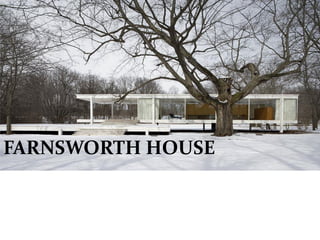Farnsworth house
- 2. âĒIntroduction âĒArchitect âĒSite Plan âĒStructure âĒPlan âĒSection âĒElevation âĒSpaces âĒInterior âĒMaterials âĒDrawbacks âĒConclusion
- 3. âĒArchitect: Ludwig Mies van der Rohe âĒYear(s) of design: 1945- 1950 âĒYear(s) of Contruction:1950-1951 âĒLand Area: 240,000 sq.m âĒFloor Area:206 sq.m âĒLocation: Springfield, Illinois, United States
- 4. âĒWidely recognized as an iconic masterpiece of International Style of Architecture.
- 6. Architect
- 7. Ludwig Mies van der Rohe âĒGerman-American architect. âĒcreated an influential 20thcentury architectural style, stated with extreme clarity and simplicity. âĒHe called his buildings âskin and bonesâ architecture. âĒHe sought a rational approach that would guide the creative process of architectural design. âĒâless is moreâ and âGod is in the detailsâ.
- 8. âĒExtensive use of clear floor-to- ceiling glassopens the interior to its natural surroundings to an extreme degree. âĒTwo distinctly expressed horizontal slabs, which form the roof and the floor, sandwich an open space for living. âĒThe slab edges are defined by exposed steel structural members painted pure white. âĒThe elongated rectangle of the house lies parallel to the course of fox river.
- 10. âĒEntranceon the sunny side facing the river instead of street. âĒSuspended stairways represented by the perpendicular axis faces the river directly. âĒSimple elongated cubic form of the house parallel to the flow of the river âĒTerrace platform is slipped downstream in relation to the elevated porch and living platform. âĒOutdoor spaces are extensions of indoor space with ascreened porch andopen terrace.
- 11. ROOF PLAN
- 12. âĒMies applied the concept of an unobstructed space that is flexible for use by people. âĒThe interior appears to be a single open room, its space ebbing and flowing around two wood blocks âĒThe building is essentially one large room filled with freestanding elements that provide subtle differentiations within an open space, zones for sleeping, cooking, dressing, eating and sitting. âĒVery private areas such as toilets and mechanical rooms are enclosed within the core.
- 13. SECTION âĒThe house is elevated 1.60 m above a flood plain by 8 wide flange steel columns which are attached to the sides of the floor and ceiling slabs.
- 14. âĒFarnsworth House is the ultimate expression of minimalism-using only the minimum necessary to ensure the stability of the house. âĒMinimum elements include 8 columns, separated by a distance of 6.60m, supporting the two slabs that forms the floor and the ceiling.
- 15. âĒThe 2.75m terrace slab, supported by only 4 columns and leading to the entrance helps to emphasize the immateriality of the house
- 16. ELEVATIONS
- 17. âĒThe floor is set in two layers, between which is the plumbing & drainage system. âĒThe domestic plumbing elements and also the rainwater run-off spill into a central circular chest. âĒThe roof, while mostly flat, is slightly inclined towards the center to force water to run toward the edges.
- 18. âĒA third floating slab, an attached terrace, acts as a transition between the living area and the ground. âĒThe house is accessed by two sets of wide steps connecting ground to terrace and then to porch âĒBuilding with free and open space within a minimal framework
- 19. S P A C E S âĒA central wooden core contains sanitary facilities and creates a separation between the kitchen, two bedrooms and the living room. âĒThe 111 sq.m terrace is extended towards a meadow an the levels are communicated by means of stairs.
- 21. Materials âĒThe architectural work is done in steel, laminated glass plates & Roman travertine on the floor and deck. âĒMill-formed steel and plate glass â represent modern era. âĒRoman travertine and exotic wood veneers- traditionalism.
- 22. âĒAll the steel pillars that hold both the platforms are of square section and have been blasted and polished. ïķThey are painted white, making their welds virtually invisible.
- 23. Drawbacks âĒLack of traditional warmth and coziness. âĒPoor energy efficiency. âĒProved difficult to live in. âĒIt lacks air conditioning & therefore, in the warm seasons, produces an effect similar to that of a greenhouse.
- 24. âĒMies talks about free space, but his space is very fixed.
- 25. INDOOR TO OUTDOOR VIEWS
- 26. OUTDOOR TO INDOOR VIEWS
- 27. Service care becomes the diagram of the house as a machine, the kitchens and back to back bathrooms stand in a logical, utilitarian relationship to one another.




























